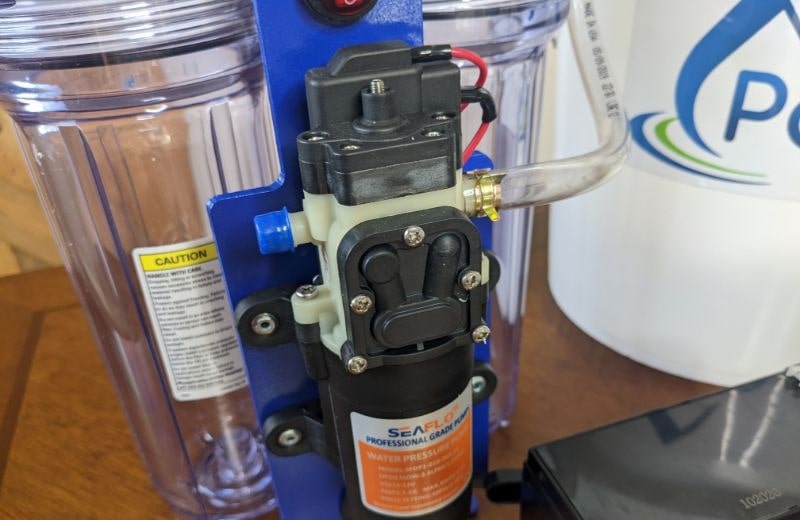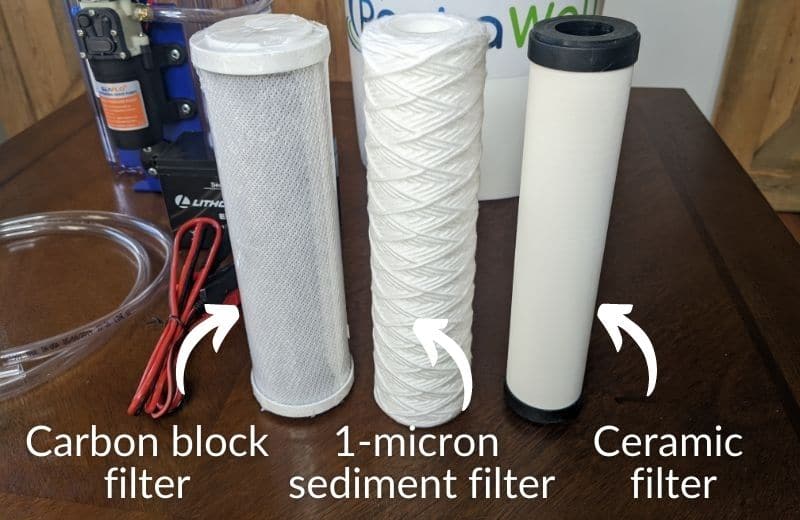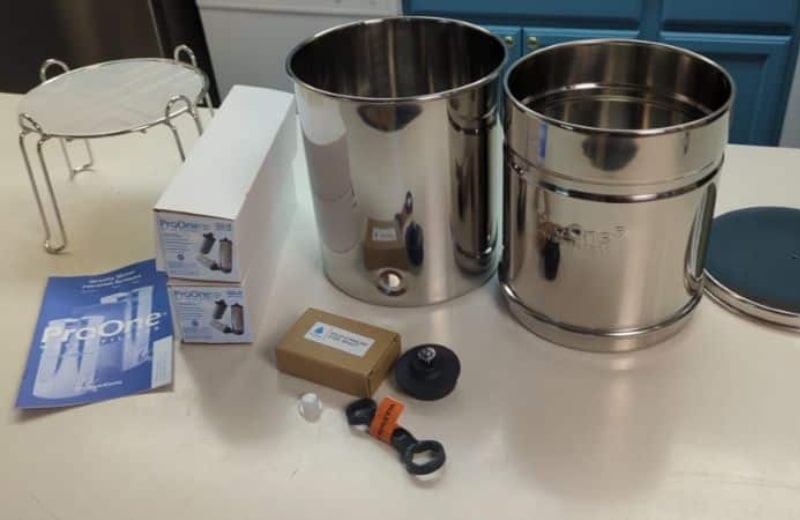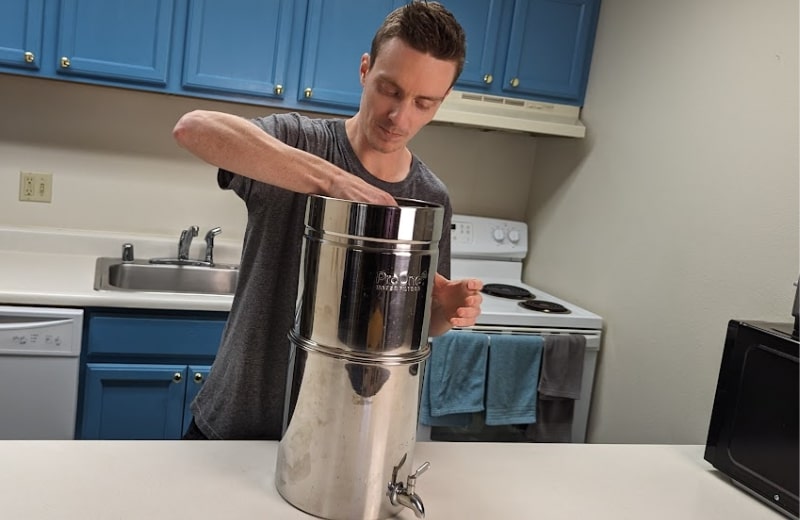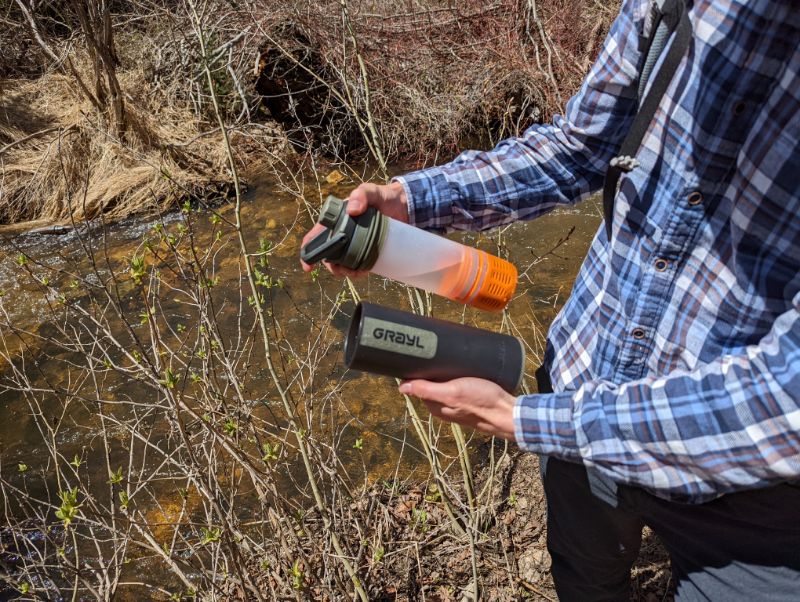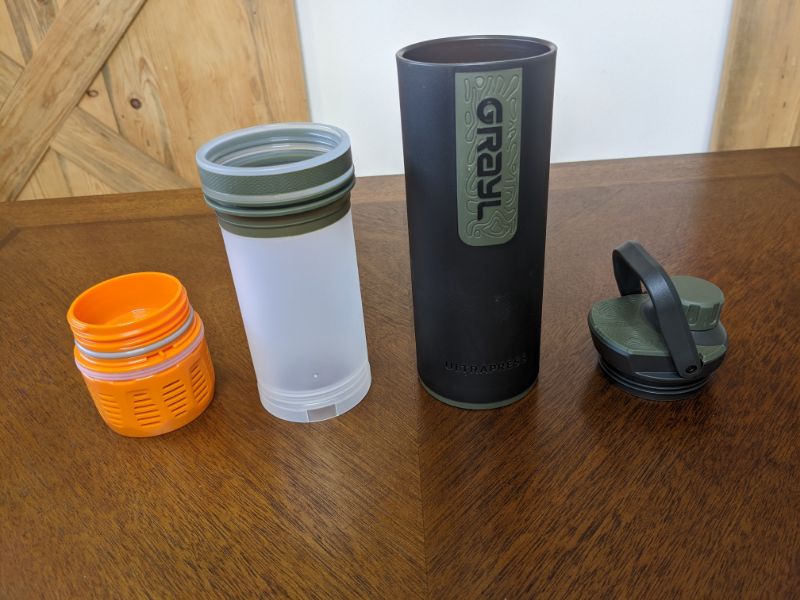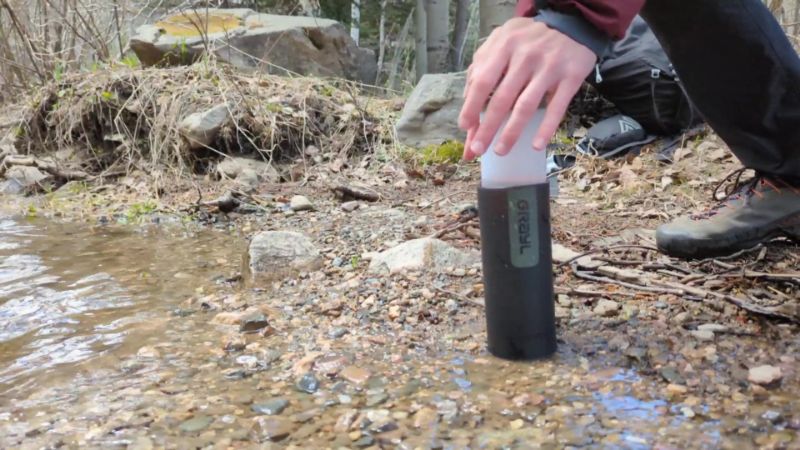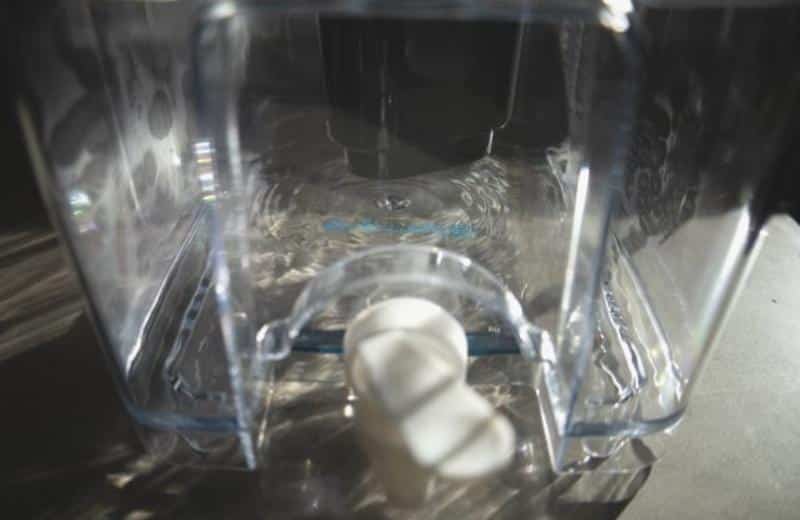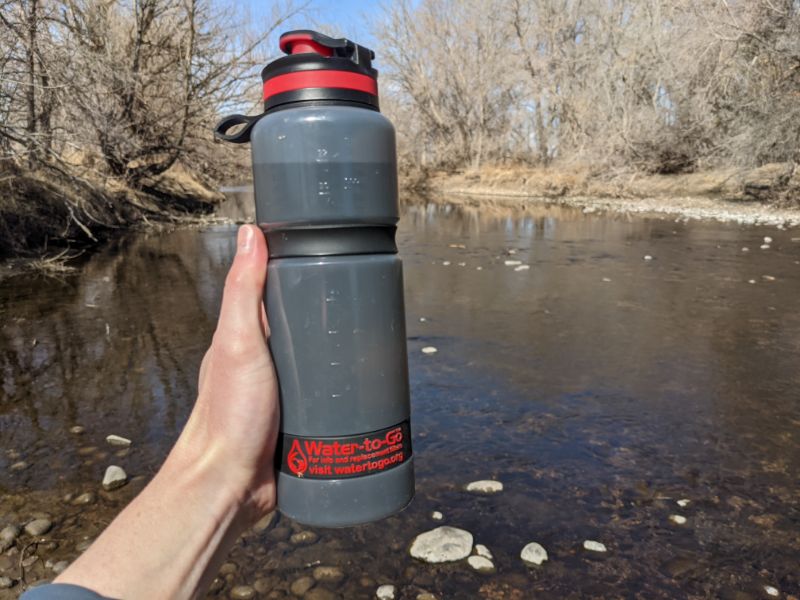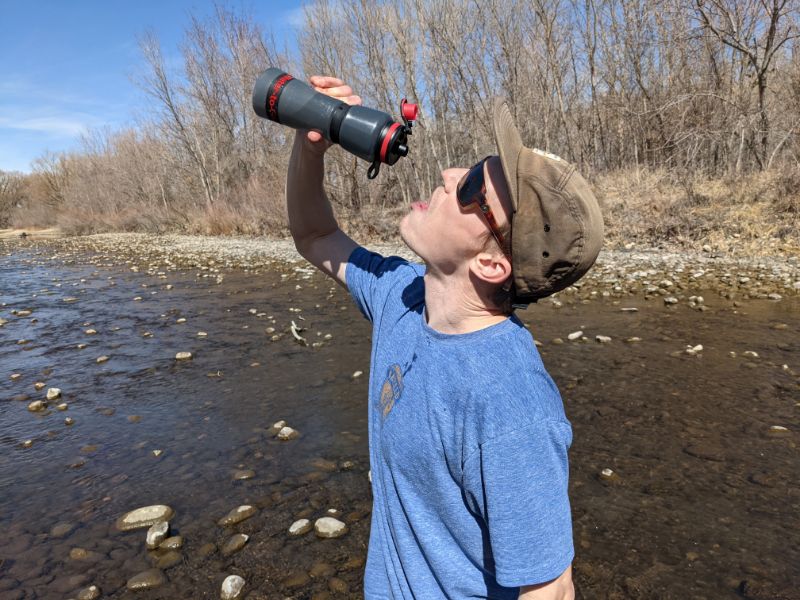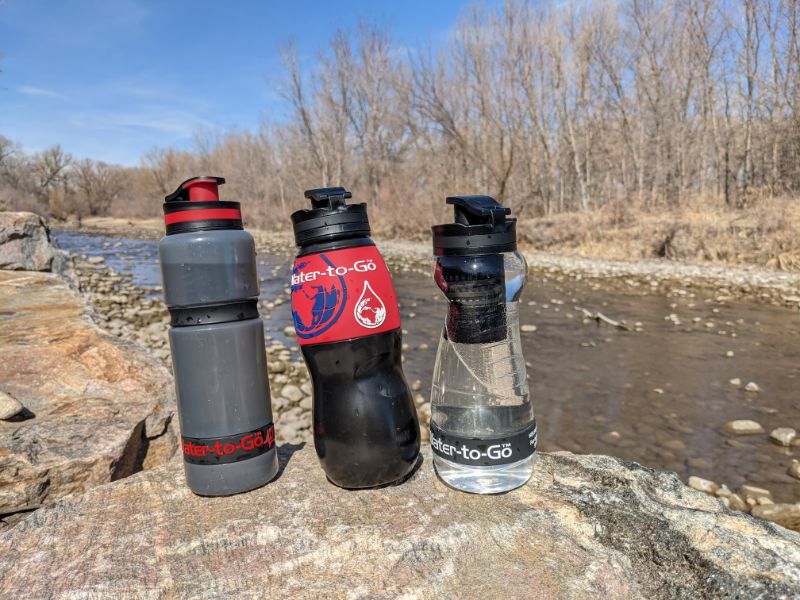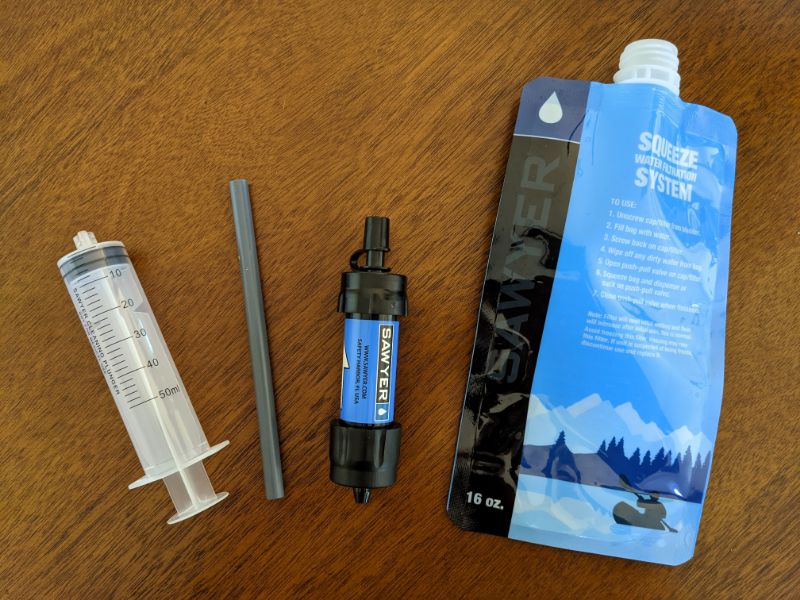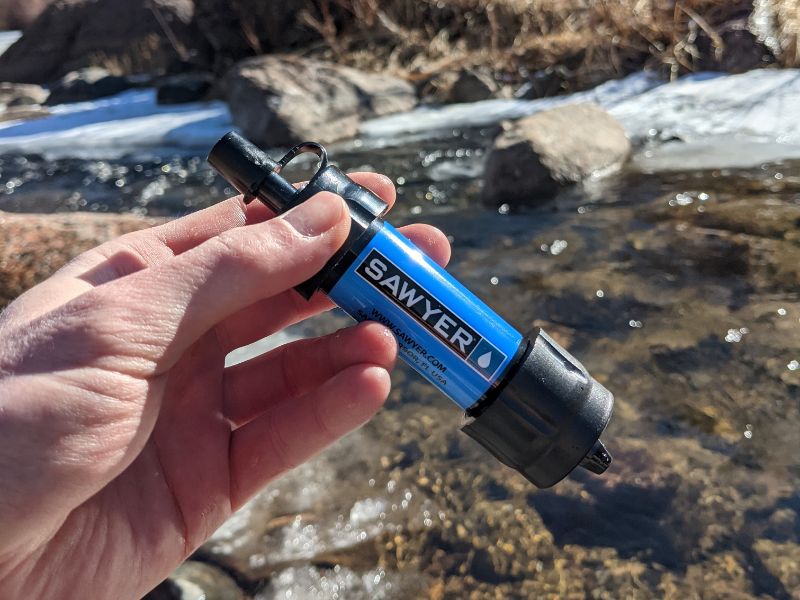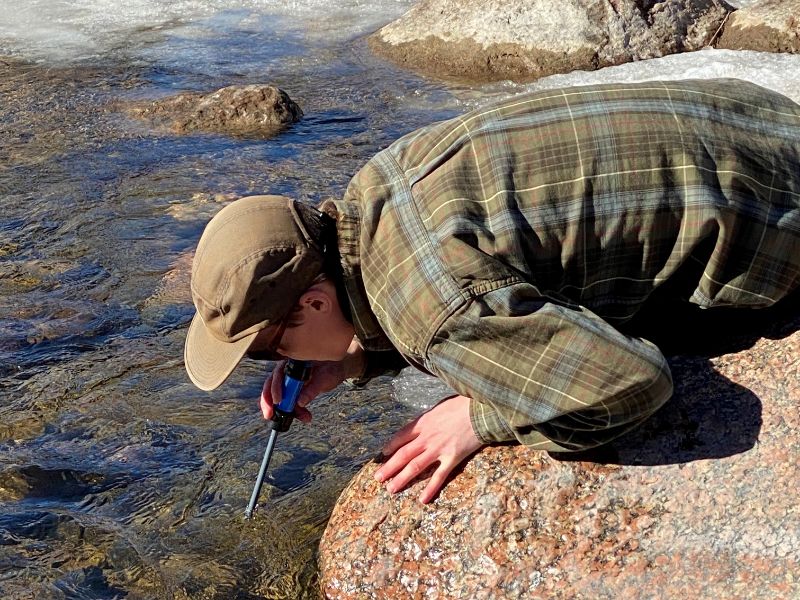You never know when your access to clean tap water might be compromised. We’ve tested dozens of the best emergency water filters for survival, and these are our top picks based on contaminant removal, reliability, durability, and value for money.
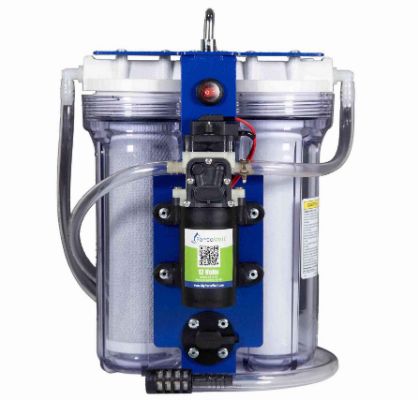
PortaWell
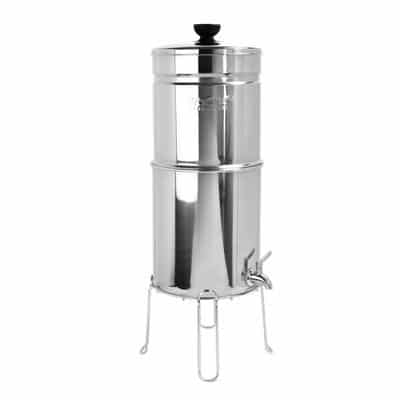
ProOne Big+
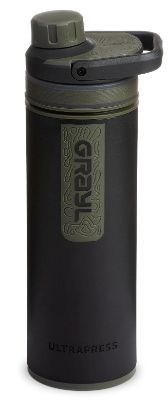
Grayl Ultrapress
In most parts of the US, we’re very fortunate to have easy access to tap water that’s safe to drink. But you never know when your water safety or quality might be compromised. If you’ve arrived at this guide, you already know that. You’re looking for the best emergency water filter, and we’re here to help.
In all, we tested and reviewed over 20 emergency filters with untreated lake & river water, and the 9 featured below are the only ones we would trust 100%.
We’ve ranked the emergency filters on this list in order of reliability and effectiveness. If your only drinking source has been compromised by potentially dangerous contaminants, reliability is absolutely the most important feature of any emergency water filter. We also considered cost, durability, and ease of use, amongst other features, when deciding which emergency water filters are the best value for money.
Table of Contents
🥇 Best Survival Water Filters
- Best Overall: PortaWell
- Best Gravity Fed: ProOne Big+ Gravity Water Filter
- Best Filtered Bottle: Grayl Ultrapress
- Runner Up Gravity Fed: Epic Nano Water Filter Dispenser
- Runner Up Bottle: Water-to-Go Filtered Bottle
- Most Portable: Sawyer MINI Water Filtration System
- Runner Up Pump System: MSR Guardian
📊 Comparison Chart of Emergency Water Filters
| System | PortaWell | ProOne Big+ | Grayl Ultrapress | Epic Nano Dispenser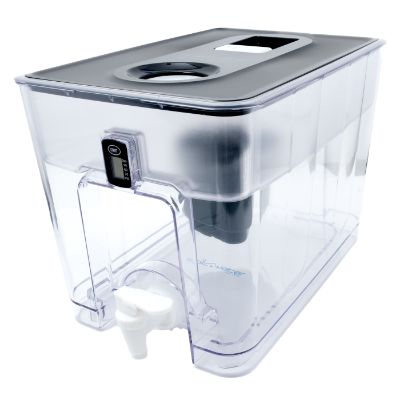 | Water-to-Go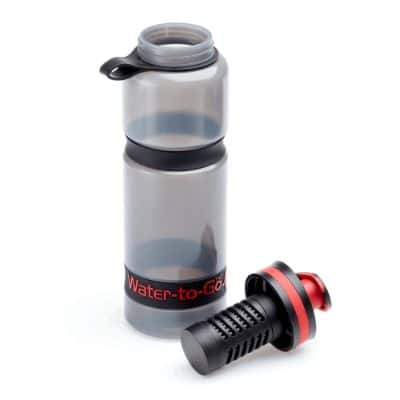 | Sawyer MINI 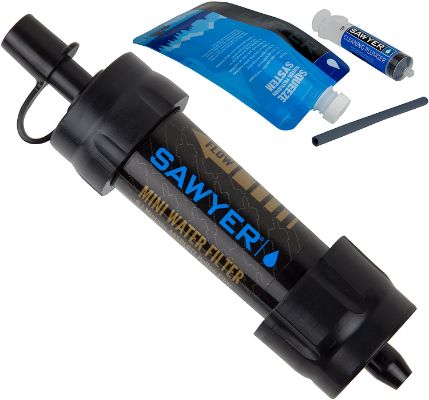 | MSR Guardian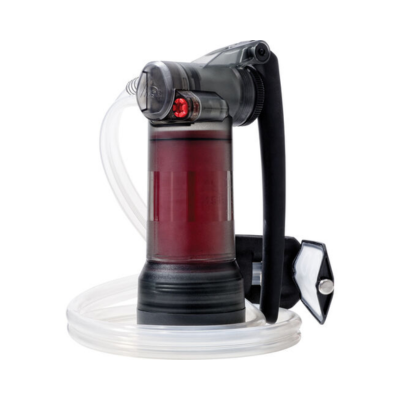 |
|---|---|---|---|---|---|---|---|
| Ranking | 1st | 2nd | 3rd | 4th | 5th | 6th | 7th |
| Ratings | 5/5 | 5/5 | 4.5/5 | 4.5/5 | 4/5 | 4/5 | 4/5 |
| Price | $359 | 229.95+ | $89.95 | $75 | $95.98 | $24.95 | $389.95 |
| Type | Pump dual filtration | Gravity | Bottle | Gravity | Bottle | Straw | Pump |
| Filter Capacity | Sediment: 6 mos Carbon: 1,000 gal Ceramic: 15,000 gal | 1,200 gallons | 55 gallons | 150 gallons | 52 gallons | 100,000 gallons | 10,0000 liters |
| Pathogen Removal | Bacteria, Viruses, Cysts | Bacteria, Viruses, Microbial Cysts | Bacteria, Viruses, Cysts | Bacteria, Viruses, Cysts | Bacteria, Viruses, Cysts | Protozoa, Bacteria | Protozoa, Bacteria, Virus |
| Contaminants Removed | 200+ | 200+ | 15+ | 200+ | 99% of all Biologicals | 99% of all Biologicals | 99% of all Biologicals |
| Certifications or Testing | NSF 42 | NSF 42, 53, P231 | NSF 42 & 53 | NSF 42, 53, 401, P473, & P231 | USEPA Guide Standard (1986) and Protocol for Testing Microbiological Water Purifiers | USEPA Guide Standard (1986) and Protocol for Testing Microbiological Water Purifiers | NSF P248 |
| Process | Mechanical + Carbon + Ceramic | Ceramic | Electroadsorptive Activated Carbon + Ion Exchange | Mechanical + Electroadhesion + Ion Exchange | Mechanical + Carbon Electroadhesion | Hollow Fiber Membrane | Hollow Fiber Membrane |
| Annual Cost | ~$40 | ~$100 | ~$180 | ~$140 | ~$100 | – | ~$0 |
| Warranty | 1 year | 5 years limited 1 year limited on ProOne® G2.0 | 10 years | Lifetime | – | Lifetime | Limited Lifetime |
⭐ Reviews – Best Survival Water Filter 2025

PortaWell
In our opinion, the PortaWell is a the best overall survival water filter available today. This high-volume portable water filter uses a battery-operated pump and can filter water at a rate of 40-60 gallons per hour, removing 100% cysts and more than 99.9% pathogenic bacteria.
Specs
| rice | $359 |
| Type | Pump dual filtration |
| Filter Capacity | Varies by cartridge |
| Pathogen Removal | Bacteria, Viruses, Cysts |
| Contaminants Removed | 200+ |
| Certifications or Testing | Ceramic Filter: NSF 42 |
| Process | Mechanical + Carbon + Ceramic |
| Annual Cost | Varies |
| Warranty | 1 year |
Our PortaWell system was shipped with three filters, but there’s space for only two filters in the unit itself. That meant we could mix and match, choosing the best pair of filters for our situation (or using all three by filtering the same batch of water twice and swapping a filter before the second run-through). Also included was the pump itself (which is battery-operated), and a 5-gallon bucket to collect the water. The battery is sold separately – it costs around $40 on the PortaWell website. This was our only gripe with the system’s design; we think it should be included in the purchase given it’s essential for the pump’s operation.
When we got the PortaWell Filtration System, it cost around $329, so it’s not the most budget-friendly emergency filter. But, it offers a much more thorough purification solution than many of the other systems we tested, with its three dedicated filter stages, and it produces filtered water at a much faster rate than the handheld alternatives – so we felt we’d get superior water treatment that justified the higher upfront cost.
Best For:
Anyone looking for a fast, convenient emergency water filtration solution that’s easy to transport and store and provides purified drinking water for groups or families.
What We Like:
- Battery-powered pump eliminates the need for hand-pumping
- Three filters that can be rotated based on your filtration needs
- Targets more contaminants than most other emergency filters
- Long filter lifespan
What We Don’t Like:
- Takes longer to set up for use
- No battery included in the upfront purchase (it’s sold separately)
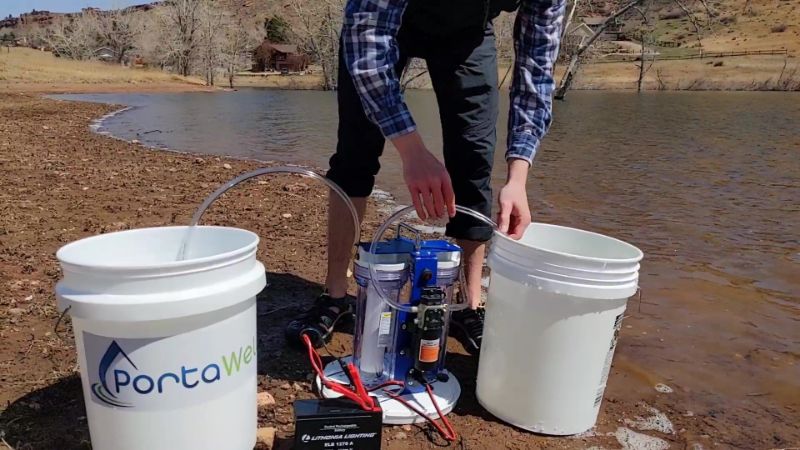
Remove Tens Of Contaminants With Three Dedicated Filter Stages
Our biggest priority in any emergency water filter was to remove microorganisms – and the PortaWell ticked our boxes with its ability to remove pathogenic bacteria and cysts. But, unlike many of the other emergency filters we tested, microorganisms aren’t the only contaminants that this filtration system targets. With multiple separate filter cartridges, it also reduces or removes pesticides and herbicides, volatile organic chemicals, pesticides, chlorine, sediment, and more.
Most pump filters use just one or two filter stages, but the PortaWell Filtration System has three: a 1-micron sediment filter, a carbon block filter, and a 0.5-micron absolute ceramic filter. As we mentioned, you can only use two filters at a time in the system, and we enjoyed being able to mix and match the different filters for different purposes: the sediment and absolute ceramic filters were an ideal combination for treating surface water containing pathogenic bacteria and sediment, and we could then swap the ceramic filter for the carbon block filter to also target pesticides, herbicides, chlorine, and contaminants affecting taste and odor. We know that some folks might find it a hassle having to swap out the filters, but we were glad to have a dedicated sediment filter that we could use to remove large particulates from natural water sources without having to DIY our own makeshift filter for this purpose. If you’re filtering a low-sediment tap water source, you can simply ignore the sediment filter and use the ceramic and carbon filters together.
Filters Water With A Battery Pump
We found the PortaWell system a little more time-consuming to set up than some of the more basic emergency filters we reviewed. We had to organize and connect the tubes, battery, filters, bucket, and cables before we could even begin the filtration process. But the good news was that once the assembly and setup were complete, we didn’t have to lift a finger because the pump is battery-operated. No hand-pumping required!
The fact that the pump uses battery power also meant that we had much faster access to safe, clean water than most of the gravity systems we tried. The pump has a fast filtered water flow rate of 40-60 GPH, and we found that we were able to filter 1 gallon of water in just over a minute – that’s around 2.5 times the filtration speed of a hand-pump system. We found it convenient to be able to collect water in the roomy 5-gallon bucket before transferring it to other containers. We will say, however, that with a weight of just under 15 pounds, it’s not the best solution if you’re packing light. We pictured this as a great option to store in a cupboard or a survival stash for emergency use.
It was reassuring to know that the filters are designed to last a long time. The carbon and sediment filters have a 1,000-gallon lifespan, while the ceramic filter can filter up to 10,000 gallons and could be renewed when necessary – we just washed it under running water to clear the debris.
Read the full review: Portawell Review (Updated for 2025)

ProOne Big+
The ProOne Big+ is our top pick as the best gravity-fed emergency water filtration solution. This durable stainless steel countertop filter can remove more than 270 impurities, including chlorine, fluoride, lead, VOCs, bacteria, and protozoa – and it doesn’t use electricity or water pressure, so it can be used in emergency situations where these might not be available.
Specs
| Price | 229.95+ |
| Type | Gravity |
| Filter Capacity | 1,200 gallons/filter |
| Pathogen Removal | Bacteria, Viruses, Microbial Cysts |
| Contaminants Removed | 200+ |
| Certifications or Testing | NSF 42, 53, P231 |
| Process | Ceramic filter media |
| Annual Cost | ~$100 |
| Warranty | 5-year limited warranty (Stainless steel unit), 1-year limited warranty (ProOne® G2.0) |
Our first impressions of the ProOne Big+ were that it has one obvious convenience compared to the PortaWell system: it’s a gravity filter, so we wouldn’t have to worry about having a charged battery to use in an emergency situation. Instead, the unit uses the ever-reliable force of gravity to send water down through a ceramic filter (or filters) and into the bottom chamber, where it can be dispensed for drinking. However, this difference did mean that we wouldn’t be able to access large batches of filtered water very quickly in an emergency scenario because of the slow-and-steady rate of gravity filtration. The great thing about the Big+ is that it’s designed to treat both potable and non-potable water sources, so we could use it for everyday filtration and on an emergency basis.
Pricing for this system varies depending on how many filter elements you buy (it can fit up to 3). The unit with a polished stainless steel finish and a single G2.0 7-inch filter element costs $229.95. We chose to upgrade to the unit with 2 filters, which meant we’d be able to filter more water at once. If you want an emergency water filter solution for a big group or family, our advice is to go for the unit with 3 G2.0 9-inch filter elements, which costs around $370. We estimated we’d spend less than $100 annually on maintenance, assuming that we’d only have to replace the filters once a year.
| ProOne Big+ Options | Price (Polished) | Price (Brushed) |
|---|---|---|
| 1 G2.07 Filter Element | $229.95 | $239.95 |
| 2 G2.07 Filter Element | $289.95 | $299.95 |
| 3 G2.09 Filter Element | $369.95 | $379.95 |
Best For:
Anyone looking for a water filter that filters big batches of water for emergency use and produces clean, great-tasting water regardless of the source.
What We Like:
- Reliable gravity-fed filtration process
- Removes 200+ contaminants
- Long filter lifespan
- Doesn’t need a battery or water pressure
What We Don’t Like:
- Large & takes up a lot of space
- Gravity filtration is fairly slow

Easy To Assemble & Use
Facing an emergency scenario is stressful enough, and the last thing you want is the extra stress of having to work out how to assemble and use a complex system. We found that the Big+ was one of the best systems we tested when it came to ease of assembly and use, taking us less than 20 minutes to set up following the 5-step assembly instructions in the user manual.
Using the system was also a piece of cake: we just poured water into the upper chamber and waited for it to filter through into the bottom. We felt particularly reassured by the system’s gravity-fed filtration process – no matter the emergency scenario, gravity will always exist, which meant we knew we’d be able to use the system in all situations as long as we had access to a water source. This didn’t need to be water from the tap, either, since the Big+ can be used to filter natural water sources, so we could use it to filter water from a stream or river if necessary.
Yes, gravity filtration is pretty slow and steady (with our two 7-inch filters, we noted a filtration speed of around 0.52 gallons per hour – much slower than the 40-60 GPH filtration speed). But because the unit holds 3 gallons of water, we found it easy and low-effort to fill the top chamber and simply leave it to filter water over the next 5-6 hours. We could dispense water from the spigot while it was filtering, so we didn’t have to wait for a full batch of water to filter first.
Superior 200+ Contaminant Removal
Like the PortaWell system, the ProOne Big+ has the advantage of removing more than just microorganisms. It has been third-party tested to NSF Standards 42, 53, P231, P401, and P473 to remove 200+ contaminants, so it’s a great choice for anyone who’s looking for the most thorough water filtration solution, helping to not only make water safe to drink, but also improving its quality, taste, and smell.
We were able to test our own water supply before and after using the Big+ to see exactly what it was capable of removing. We filtered untreated water from a river in Colorado through the system, and our test results showed that the ProOne completely removed all bacteria from this water source, including E. coli, Enterococcus, and total coliform.
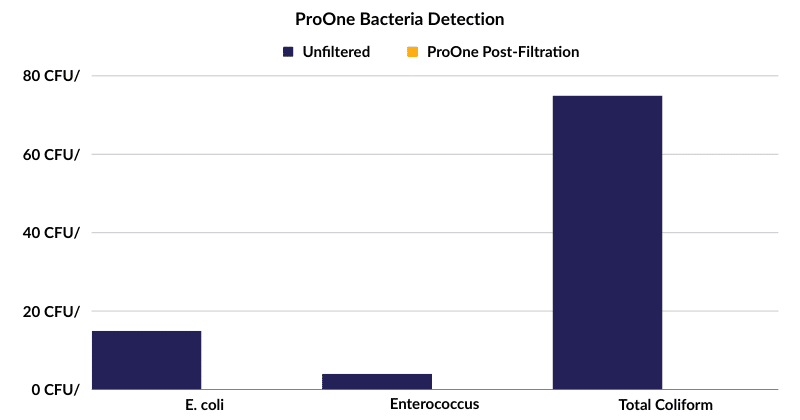
The filters also eliminated manganese and aluminum, reduced sulfate by 35%, and removed 80% of the water’s iron content. We also tested the system’s ability to remove a different set of contaminants from our city water source, and it removed 100% of lead, aluminum, copper, fluoride, and manganese. It also reduced the two disinfection byproducts present in the water by around 50%.
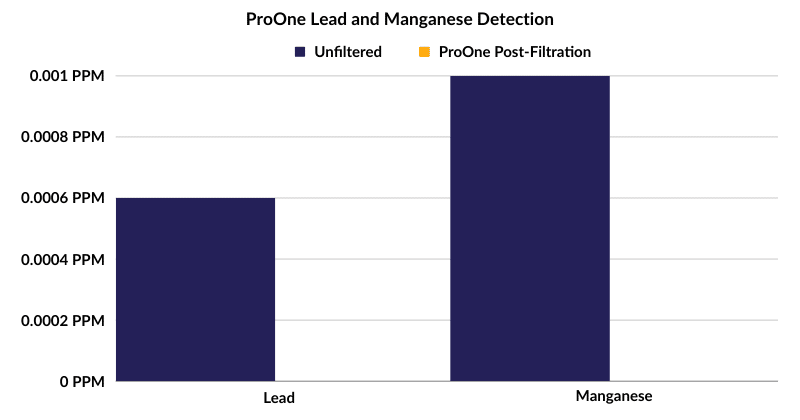
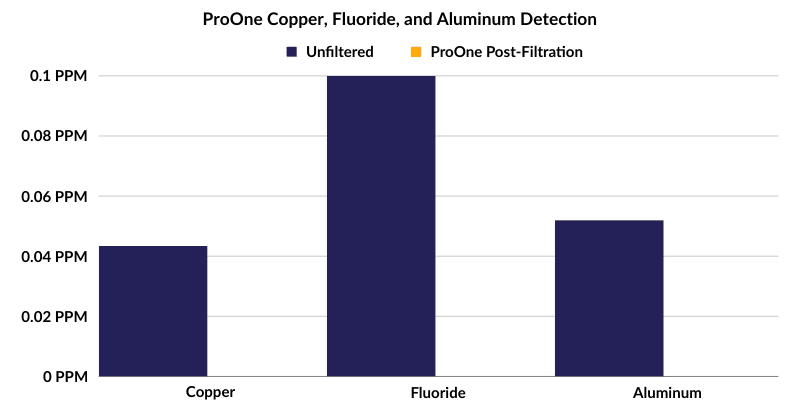
Learn more about the contaminants removed by the ProOne Big+ with our third-party laboratory analysis below.
| Contaminant | Measurement | Priming Water | Test 1 Pre-Filtration | Test 1 Post-Filtration | % Reduction | Test 2 Pre-Filtration | Test 2 Post-Filtration | % Reduction |
|---|---|---|---|---|---|---|---|---|
| Aluminum | PPM | ND | 0.052 | 0 | -100.00% | 0.03 | 0 | -100.00% |
| Barium | PPM | 0.0265 | 0.0127 | 0.0275 | 116.54% | ND | ND | ND |
| Bromodichloromethane | PPB | 0.00289 | 0 | 0.00319 | n/a | ND | ND | ND |
| Calcium | PPM | 35.1 | 8.8 | 19.3 | 119.32% | ND | ND | ND |
| Chloride | PPM | 14.4 | 6.9 | 8.3 | 20.29% | ND | ND | ND |
| Chloroform | PPB | 0.0141 | 0.0352 | 0.0155 | -55.97% | ND | ND | ND |
| Cobalt | PPM | 0.0013 | ND | ND | ND | ND | ND | ND |
| Copper | PPM | 0.0424 | 0.0434 | 0 | -100.00% | ND | ND | ND |
| E. coli | CFU/100ml | ND | ND | ND | ND | 15 | 0 | -100.00% |
| Enterococcus | CFU/100ml | ND | ND | ND | ND | 4 | 0 | -100.00% |
| Fluoride | PPM | 0.1 | 0.1 | 0 | -100.00% | ND | ND | ND |
| Iron | PPM | ND | ND | ND | ND | 0.1 | 0.02 | -80.00% |
| Lead | PPM | 0.0009 | 0.0006 | 0 | -100.00% | ND | ND | ND |
| Magnesium | PPM | 10.6 | 2.19 | 7.91 | 261.19% | ND | ND | ND |
| Manganese | PPM | ND | 0.001 | 0 | -100.00% | 0.02 | 0 | -100.00% |
| Phosphorus | PPM | ND | ND | ND | ND | 0.01 | 0.21 | 2000.00% |
| Potassium | PPM | 1.91 | 0 | 1.27 | n/a | ND | ND | ND |
| Sodium | PPM | 12.5 | 10.4 | 14.2 | 36.54% | ND | ND | ND |
| Strontium | PPM | 0.193 | 0.062 | 0.098 | 58.06% | ND | ND | ND |
| Sulfate | PPM | 24.1 | 10 | 16.9 | 69.00% | 42.29 | 27.4 | -35.21% |
| Total Coliform | CFU/100ml | ND | ND | ND | ND | 75 | 0 | -100.00% |
| Total THMs | PPB | 0.01699 | 0.0352 | 0.01869 | -46.90% | ND | ND | ND |
Read the full review: ProOne Big Review

Grayl UltraPress
Based on our testing, the Grayl UltraPressis the best filtered water bottle you can buy for emergency use. This BPA-free 16 oz water filter bottle impressed us with its ability to eliminate up to 99.99% of viruses, bacteria, and protozoa, as well as particulates (including sediment and microplastics), heavy metals like arsenic and lead, VOCs, and chemicals like benzene and chloroform. Plus, we found it super simple to use, with a press design rather than a built-in straw filter.
Specs
| Price | $89.95 |
| Type | Bottle |
| Filter Capacity | 55 gallons |
| Pathogen Removal | Bacteria, Viruses, Cysts |
| Contaminants Removed | 15+ |
| Certifications or Testing | NSF/ANSI 42 & 53 |
| Process | Electroadsorptive Activated Carbon + Ion Exchange |
| Annual Cost | ~$180 |
| Warranty | 10 years |
In terms of appearance and design functionality, the Grayl Ultrapress was exactly what we were looking for in a personal emergency water filter. The bottle is slim and compact, and we could easily store it in a cupboard or emergency survival kit, but it holds a decent amount of water 16 oz (473 ml). It has a sturdy, durable feel and withstood our bump and drop tests without getting cracked or dented, and the non-slip rubber grips meant it was easy to carry, even when full. Weighing around 10.9 ounces without any water, it’s not the lightest emergency water filter we’ve tried, but it’s also not disruptively heavy or bulky.
We went for the Nature Edition bottle, which cost around $100. We’ve tested cheaper filtered water bottles, but the Grayl UltraPress outshone them all as being the best at removing the broadest range of contaminants, including viruses – exactly what we want to see in an emergency water filtration solution. We expected to spend $150-$180 annually on filter changes, depending on use of course.
Best For:
Folks looking for a personal emergency water filtration solution that they can take with them on the go for low-hassle purification of their drinking supply.
What We Like:
- Good water-holding capacity
- Easy, quick filtration
- Removes microorganisms & other contaminants
- One of the few filters to remove viruses
What We Don’t Like:
- Costly for a bottle filter
- Filter life is quite short
Press Bottle Filtration
The Grayl UltraPress is a press bottle filter, meaning that the force of pressing the bottle sends water through the filter, which traps contaminants. Personally, we prefer a press bottle filter to a bottle with a straw filter, since press bottles eliminate the difficulty of sucking water through a straw filter. We didn’t have to fuss around with setup – we simply filled the bottle with water from a nearby stream, placed it on a flat surface, put the lid on, and pressed the top of the bottle downwards to send water through the filter. We could filter an entire batch of water in less than 10 seconds, rather than having to filter water gradually every time we sucked through a straw, and the process of pressing down on the bottle wasn’t too strenuous thanks to the vented bottle cap.
With its wide-neck design, the Grayl UltraPress is easy to clean between uses. It lasts up to 350 presses – plenty to carry you through in an emergency situation. However, the filter lifespan depends on the quality of the water you’re filtering, and to stay on the safe side, we filtered our dirtier water sources through a DIY cloth filter to get rid of the sediment before using them to fill the UltraPress bottle.
Impressive Contaminant Removal
Many of the water bottle filters we’ve tested can either remove microorganisms or remove chlorine, tastes, and odors. The UltraPress is one of the few filters of its kind that can be used to make microbiologically contaminated water safe to drink and remove chemicals, metals, and tastes, improving overall water quality. This bottle filter combines powdered activated carbon and ion exchange media, which can remove bacteria, viruses, protozoa, sediment, microplastics, heavy metals, PFAS, VOCs, and some chemicals. We were particularly impressed with the filter’s ability to remove viruses, since only around 20-30% of filters for emergency purposes can remove this tiny contaminant. While water sources in the U.S. rarely get contaminated with viruses, we felt reassured to know that we’d be protected against viruses in any hypothetical emergency situation. We noticed an improvement in our water’s taste after using the UltraPress to filter water from a natural source – something that only carbon filtration can achieve.
Grayl’s filter performance claims are supported by third-party laboratory testing in accordance with NSF Standards 42 and 53, for the removal of sediment, chemicals, and pathogens, and the UltraPress filter also meets the U.S. Environmental Protection Agency’s protocols for for microbiological water purifiers, offering the reassurance of industry-standard water treatment.

Epic Nano Water Filter Dispenser
The Epic Nano is our runner-up gravity-fed filter, taking second place to the ProOne Big+. This countertop water dispenser capable of filtering up to 99.999% of more than 200 common drinking water contaminants, including viruses and bacteria.
Specs
| Price | $75 |
| Type | Gravity |
| Filter Capacity | 150 gallons |
| Pathogen Removal | Bacteria, Viruses, Cysts |
| Contaminants Removed | 200+ |
| Certifications or Testing | NSF 42, 53, 401, P473, and P231 |
| Process | Mechanical + Electroadhesion + Ion Exchange |
| Annual Cost | ~$140 |
| Warranty | Lifetime |
The Epic Nano is another filter that’s ideal for group use as an emergency filtration system. It’s a relatively large dispenser unit, so it’s a great static filtration solution – but it’s not going to fit in a backpack or bag. Like the ProOne Big+, the Nano dispenser uses gravity to send water through a filter, and the filtered water collects in the bottom reservoir, where it can be dispensed for drinking. Aside from a few obvious design differences (the Nano is made from BPA-free plastic, holds 1.7 gallons of filtered water, and is cube-shaped, while the Big+ is made from stainless steel, holds 3 gallons of filtered water, and is cylindrical-shaped), the systems both offer a very similar performance.
When we tested the Epic Nano Dispenser, it had an upfront cost of $60 – so it’s significantly cheaper than the Big+. But its filter lifespan of up to 150 gallons is also much lower. While we only expected to replace the filters in the Big+ once a year, we were looking at at least 4 filter changes a year with the Nano dispenser (we expected to spend around $50 annually on maintenance).
Best For:
Families and groups who want an affordable, no-fuss emergency gravity filtration system that removes microorganisms, chemicals, heavy metals, and more, making even dirty water safe to drink.
What We Like:
- Removes 200+ contaminants
- Good 1.7-gallon water holding capacity
- Requires no complicated setup or use
- Reliable gravity filtration
What We Don’t Like:
- Takes a while to filter water
- Short filter lifespan
Simple, Effective Gravity Filtration Process
Of all those we tested, the Epic Nano was hands-down the easiest emergency water filter to set up and use. Out of the box, it has a super simple design, with no fiddly parts or complicated filter priming requirements. We simply rinsed the shell and reservoir in warm, soapy water, assembled the top reservoir on the bottom, filled the dispenser, then discarded the first batch of water. We reckon most people should find this process really easy to follow, even if you’re slightly frazzled during an emergency scenario.
The Nano dispenser is one of the only dispensers we’ve found that can remove microorganisms, including viruses, so it’s ideal for emergencies where you don’t know how your drinking water quality might have been compromised. But it doesn’t only target pathogens like some filters – it also reduces or removes chemicals, heavy metals, pesticides, pharmaceuticals, and more. Some of the contaminants the filter has been third-party tested to remove include Virus MS2 Phage (99.95%), E.Coli (99.9999%), giardia (99.909%), cryptosporidium (99.999%), lead (99.4%), chromium-6 (96.6%), and fluoride (68%).
Because it can remove common drinking water contaminants as well as making water potable, the Nano dispenser can be used as an everyday water filter system and emergency purification solution. If you do choose to use the system every day, you’ll appreciate the built-in countdown timer, which tells you when to replace the filter based on how long you’ve used it. It was important to us that the filter worked reliably to remove pathogens and other contaminants from our water, so we felt reassured that we wouldn’t unintentionally use the filter beyond the end of its lifespan.

Water-to-Go Filtered Bottle
The Water-to-Go Filtered Bottle, our runner-up bottle filter for emergency use, is a filtered water purifier bottle that comes in two different BPA-free styles and sizes. Using 3-in-1 filter technology, this filter is one of the best water filters in a bottle for producing clean, potable water on the go, removing more than 99.99% of all microbiological contaminants.
Specs
| rice | $95.98 |
| Type | Bottle |
| Filter Capacity | 52 gallons |
| Pathogen Removal | Cysts Bacteria, Viruses, Cysts |
| Contaminants Removed | 99% of all Biologicals |
| Certifications or Testing | USEPA Guide Standard (1986) and Protocol for Testing Microbiological Water Purifiers |
| Process | Electroadhesion + Ion Exchange Mechanical + Carbon Electroadhesion |
| Annual Cost | ~$100 |
| Warranty | – |
Comparing the Water-To-Go Bottle Filter with our top pick bottle, the Grayl UltraPress, there are a few distinct differences to mention: the Water-To-Go Bottle Filter uses a straw filter rather than push filtration, and it has a shorter filter lifespan of 2-3 months. But they have a lot of similarities, too: there’s only around a $5 difference between them price-wise, and they have similar holding capacities (the Water-To-Go bottle holds 750ml, while the UltraPress bottle holds 710ml). Plus, they both remove bacteria and viruses, alongside other microorganisms. The Water-To-Go bottle is our second pick because of its shorter lifespan and the fact that we find straw filter bottles more difficult to use.
Price-wise, we got the Water-To-Go Bottle Filter when it cost around $96. The bottle comes with 3 filters, which softens the blow of having to replace the filters every 2-3 months. If you only plan to use the bottle in an emergency scenario, you’ll appreciate being able to store a stash of multiple filters to use as and when needed. Even with more filters to change, if we were to use the bottle regularly, we’d expect to spend less than $100 on annual maintenance.
Best For:
People who want an affordable, reliable emergency personal water filter that uses straw filtration and comes with three filters with the initial purchase of the bottle.
What We Like:
- Removes most microorganisms, including viruses
- Bottle comes with 3 filters
- Easy to use
- Affordable
What We Don’t Like:
- Sucking through the straw takes effort
- Short 2-3 month filter lifespan
NASA-Approved Filtration Technology
The Water-To-Go Bottle Filter uses 3-in-1 filter technology ( which was originally created for NASA!) to reliably remove 99.9999% of all microbiological contaminants. The three filter stages are mechanical filtration (using tiny pores to trap contaminants as small as pathogens), electrical filtration (which uses a positive charge to attract and trap minuscule contaminants, and further reduces the pore size), and activated carbon (which uses adsorption to address chemicals, tastes, and odors in water). Some of the contaminants targeted are bacteria and viruses like E. Coli, Hepatitis A, and Typhus; parasites like tapeworm and threadworm, microplastics, metals like mercury, and chemicals like fluoride, chlorine, and VOCs.
These three complex filter processes are packed into a small filter, which is attached to a straw – which, in turn, is attached to the underside of the lid. When we drank through the mouthpiece on the bottle lid, the force drew water up through the filter before traveling up and out of the straw. There’s a lid that protects the mouthpiece when the bottle isn’t in use, and while the older Water-To-Go bottles were known for leaking, a 2020 design update meant that we didn’t have any issues with leaking from the lid of our newer bottle. We found the bottle too big to fit in the outside pockets of a rucksack, but you could still easily pack it in an emergency pack or suitcase without it taking up too much room or weighing your pack down.
Read the full review: Water-to-Go Filtered Water Bottle Review

Sawyer MINI Water Filtration System
The Sawyer MINI is up there with the best water purification solutions offered by the well-known survival filter brand, Sawyer Products, and is our top recommended emergency water filter for portability. This versatile personal filter removes more than 99.99% of protozoa and bacteria and is small and compact enough to fit in even the smallest emergency preparedness kit.
Specs
| Price | $24.95 |
| Type | Straw |
| Filter Capacity | 100,000 gallons |
| Pathogen Removal | Protozoa, Bacteria |
| Contaminants Removed | 99% of all Biologicals |
| Certifications or Testing | USEPA Guide Standard (1986) and Protocol for Testing Microbiological Water Purifiers |
| Process | Hollow Fiber Membrane |
| Annual Cost | – |
| Warranty | Lifetime |
The Sawyer MINI Water Filtration System is the best multi-functional emergency water filter we’ve tested. Regardless of the emergency you’re facing, you should be able to find the most convenient use for this filter – whether that’s screwed onto a disposable water bottle, attached to a hydration pack or the included drinking pouch, or used as a straw to drink directly from water sources. The filter is small and lightweight, and it required minimal effort in our testing, making it the best solution for fast, easy access to clean drinking water.
We got the MINI system when it cost just under $25 – an unbeatable price given that the filter lasts up to 100,000 gallons and has an indefinite shelf life. That means the filter can be stored for as long as necessary as an emergency water treatment solution that you can rely on whether you use it next year, in the next 10 years, or 50 years down the line.
Best For:
Anyone looking for the most portable solution for filtering water in emergency situations, which won’t take up precious storage space and has various use cases to suit different preferences.
What We Like:
- Small, portable, and doesn’t take up much storage space
- Multi-functional with 4 different uses
- Reliably removes bacteria & protozoa
- Super affordable
What We Don’t Like:
- Needs regular backflushing
- Clogs quickly when treating turbid water
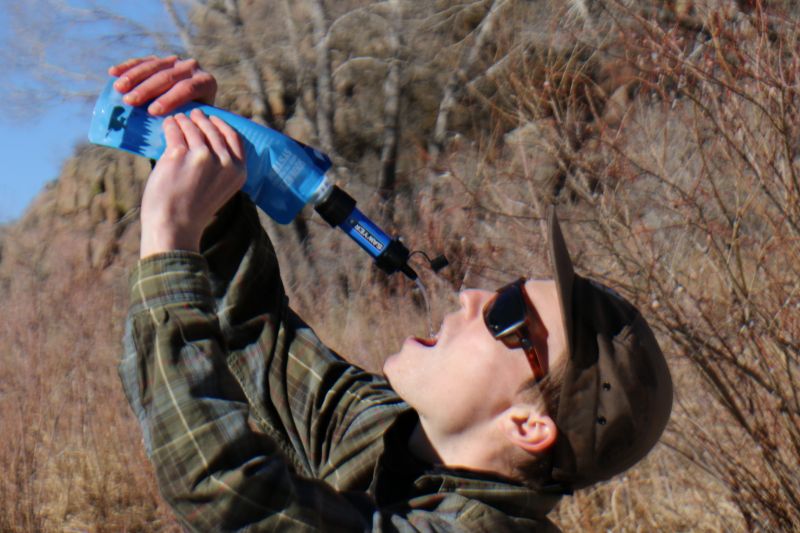
Versatile Hollow-Fiber Emergency Filtration
We know that different folks prefer to be able to use their emergency filter in different ways, and the appeal of the Sawyer MINI system is that it has multiple configurations, so you can find what works best for you. Our favorite option was to use the filter while attached to a plastic water bottle: we just filled the bottle with our available water source, then squeezed it to power water through the filter, where we could drink directly or fill a container or another bottle for later. We think this method is one of the easiest for an emergency situation, but we could also use the squeeze bag for the same purpose (a good option if you don’t have access to water bottles). On average, the speed of filtration with this method was around half a liter of filtered water per minute.
Another method that we tried was drinking straight from the water source using the included straw, and we thought this was also fast and convenient for emergencies, requiring no extra kit – although it wasn’t as easy as using the squeeze function. On its own, the MINI filter weighs just 2 ounces, so we could stash it in our small, portable emergency kit without it dominating the space.
The Sawyer MINI uses a 0.1-micron hollow-fiber membrane filter, which can trap both bacteria and protozoa, including Giardia and Cryptosporidium, but not viruses. We found that it works best when treating clear water. However, we could still use it for turbid water – it just clogged faster, so we had to backwash it more frequently with the included syringe.
- Read the full review: Sawyer MINI Water Filter Review
- Related: Lifestraw vs Sawyer Mini: Which is Better?

MSR Guardian
Based on our testing, the MSR Guardian is our runner-up pump filter for emergency use, taking second place to the PortaWell pump system. This Guardian model is a smaller and more compact alternative to the PortaWell, with just one filter cartridge and a hand-pump design.
Specs
| Price | $389.95 |
| Type | Pump |
| Filter Capacity | 10,000+ liters |
| Pathogen Removal | Protozoa, Bacteria, Virus |
| Contaminants Removed | 99% of all Biologicals, Particulates |
| Certifications or Testing | NSF P231 |
| Process | Hollow Fiber |
| Annual Cost | ~$0 |
| Warranty | Limited Lifetime |
Straight away, the obvious difference between this MSR pump filter and the PortaWell system is size. The Guardian system weighs just 1 lb 1 oz and can be comfortably held in one hand. It’s a hand-pump system, which meant we had to put in the work to manually pump water through the hollow fiber filter. Of all the filters we tested, the Guardian felt particularly durable, so we had faith that it would serve us reliably as an emergency water filter, even with unintentional rough handling.
Due to the exceptionally long filter life, we don’t anticipate to spend very much money on this one annually.
Best For:
Folks who prefer the speed and filtration capacity of a pump filter and specifically want a hand-pump filter that won’t let them down if they don’t have access to electricity.
What We Like:
- No batteries or electricity required
- Simple, easy-maintain design
- Long-lasting filter
- Super durable and sturdy
What We Don’t Like:
- Water production rate is fairly slow
- Filter needs to be cleaned frequently
- Expensive

Reliable Hand-Pump Filtration
The Guardian purifier is one of the longest-standing filters on the market – we know some folks who have used the filter for more than 20 years. That’s why we wanted to review this filter as an alternative pump system for people looking for a failsafe and reliable system that doesn’t rely on a charged battery (which you might not have access to in an emergency situation).
The filter consists of advanced hollow fiber media, with a 0.02-micron pore size. It meets NSF protocol P248 for 99.9% protozoa removal and 99.9999% bacteria removal, even in “worst-case” water, throughout its lifespan.
We assembled the filter and got set up for filtering water in just a few minutes. This involved placing the hose end in a water source and pumping the device to send water into the attached bag (or a water bottle of your choice). We found the actual manual pumping process fairly easy, but we noticed that the advertised 2.5-liters-per-minute filtration speed worked well, so we ended up producing 1 liter of filtered water in around 20-30 seconds. This filtration speed doesn’t match up to the PortaWell, with its battery-powered operation, which produces up to 60 gallons of water per hour. Still, we think the Guardian pump is fast enough to provide plenty of water for 1-3 people in an emergency situation, and because it’s manually operated, it’s more reliable on the whole.
We love the self cleaning feature of this one. Unlike with similar systems, we didn’t need to backwash the filter – or even scrub it. It cleans itself with every pump! The filter is rated to last up to 10,000 liters or more, or around 2,640 gallons. That’s not as quite long as the PortaWell filter lifespan (1,000-10,000 gallons, depending on the filter), but it’s still plenty for occasional or emergency use.
📚 Methodology: How We Tested The Best Emergency Water Filters
We wanted to be certain that our shortlisted emergency water filters were the best available across the board. We made the following considerations when ranking, reviewing, and testing the filters in this guide.
- Water purification method – We identified several effective water purification solutions for emergency situations, including boiling, chemical treatment, distillation, purification tablets, filtration in a portable water filter, and UV sterilization. In this guide, we wanted to focus on the best water filters for emergency use, since these have a few unique benefits over other methods: they’re typically quick and easy to use, they don’t require a heat source or electricity, and they’re very reliable.
- Filter type – Once we’d decided to focus on emergency water filters only, we wanted to make sure we were aware of every filter type that we could use for this purpose. In our research, we found gravity-fed water filters, inline filters (which can be used to drink directly from a water source or connected to bags, bottles, or hydration packs), water purification bottles (including straw filter bottles and push filter bottles), pump filters, and straw filters. We noted that these were all suitable for emergency use because they used filters that could remove microorganisms (and therefore could make any water source safe for drinking), and they didn’t need running water or electricity to operate.
- Source water – Next, we thought about the type of water that could possibly be available to us in emergencies, and what contaminants were the most important for us to remove. We knew that at the very least, an emergency water filtration solution needed to be able to reliably remove pathogens, including bacteria and cysts. Some of the most high-quality water filter systems we tested contained activated carbon filters and could also reduce chemicals, metals, viruses, and other common impurities that could be found in water after natural disasters or other emergencies. Our priority wasn’t to find a water filter that would make our water look, taste, and smell perfect – we focused instead on filters that reliably produced drinkable water.
- Filtration time – We knew that some folks would feel more reassured with an emergency water filter that would give them instant access to clean water, while others would be happy with a slightly longer wait time. We reviewed filters that filtered water instantly, like straw filters, press bottle filters, and squeeze filters, as well as gravity filters, which take slightly longer to filter water with a slower, steadier filtration process.
- Personal vs group use – Similarly, we identified some filters that were best suited for single-person use, while others were a better choice for groups. We found that an inline water filtration device is the best portable filtration solution for individual use, while hanging gravity bag filters and countertop gravity filters/dispensers were best for groups.
- Storage – Some of the emergency water purification systems we tested came with bags or containers for water storage, or allowed for easy dispensing into a storage container of your choice. Others, like straw filters and bottle filters, only allowed us to drink directly from the filter itself. It’s worth considering your storage preferences in an emergency water filter, especially if you factor in your daily water needs for things like washing, too. You might simply want to be able to access drinkable water during an emergency, or being able to store batches of water for multiple uses might be important. This will affect your buying decision.
- Weight and size – It’s hard to predict an emergency situation beforehand, we knew that different treatment systems would suit different situations in terms of size and weight. For folks who wanted a small, lightweight filter that they could stash in a survival kit, we tested and reviewed a range of portable water filters. For people who preferred having a larger system that they could use in a base location, we tested and shortlisted several countertop filters and larger pump filters.
- Filter longevity & maintenance – When it came to filter lifespan, some of the water filters we tested were more impressive than others. Most filters have a lifespan of around 10 years, which is pretty good, and some can last a lifetime with regular backflushing. Generally, you can judge whether a filter needs changing by its flow rate – if water is struggling to pass through the filter even with regular backwashing, it may be time for a new one. If you only plan to use a water filter during an emergency, filter lifespan is less important. As far as shelf life is concerned, most filters last decades, so you can keep your filter stored away in the knowledge that it’ll stiill be safe and effective to use in years to come.
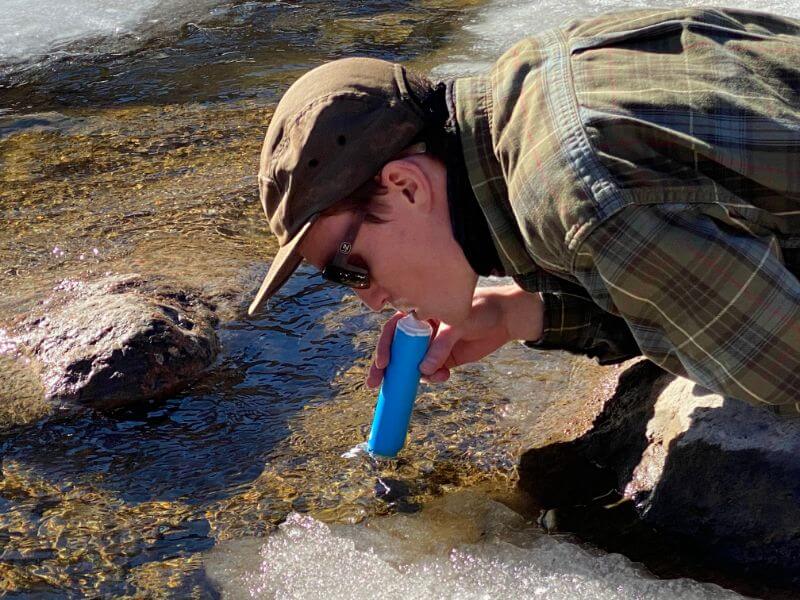
🙋 Frequently Asked Questions
Do I need a water filter for emergencies?
Yes, we would argue that everyone needs a water filter for emergencies. The thing about emergencies is that you can never plan for them. That’s why it’s a good idea to have a survival water filtration device – because you simply never know when you might not have access to safe drinking water. Many people find it reassuring to know that they can purify water no matter what situation they may face.
Are emergency purification solutions easy to use?
Yes, all the best emergency water filters are easy to use, but some are easier to use than others. Straw filters and bottle filters are the easiest to use of all and require no setup, which makes them a good option for children. In any case, look for a high-quality water filter that comes with clear instructions for use.
How do I care for a survival water purifier?
If you’re just storing a survival water filter for emergency use, keep the filter stored in a dry, clean, cool location, then follow the setup instructions when (or if) you come to use it. Once you start using an emergency filter, you’ll need to follow the manufacturer’s instructions for care. This might include backwashing the filter regularly, preferably after every use, to clear accumulated sediment and maintain a good flow rate.
How long do survival water filters last?
Unopened and unused, most survival water filters last a lifetime. Once you use the filter, it might then last 1 year, 5 years, 10 years, or even longer, as long as you follow the manufacturer’s care instructions.
What’s the difference between a water filter and a water purifier?
But scientifically speaking, a water filter uses filtration media to greatly reduce the number of contaminants in water. Water filters are a popular option amongst survival preppers as they physically remove contaminants, but they don’t remove all microorganisms (most can’t remove viruses, for instance). A water purifier, on the other hand, purifies water by targeting microorganisms. Water purifiers don’t usually filter impurities from water. Instead, they’ll use a technique like UV purification or distillation to either separate water from its impurities or kill the impurities and prevent them from causing harm.
🤓 About Our Experts
This article was produced by Brian Campbell, WaterFilterGuru.com’s Founder, and Jennifer Byrd, our water treatment specialist. To learn more about who they are and what they do, check out their author bios below.


